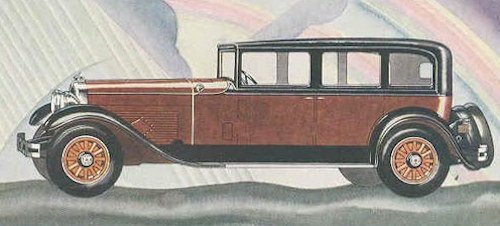Stutz Blackhawk
 |
|
|
Manufacturer |
Stutz |
|
Production |
1928 to 1930 |
|
Class |
Motor car |
|
Body |
Roadster |
|
Engine |
six-eight cylinder |
|
Transmission |
Four-speed manual |
|
Wheel base |
127-131 inch |
The Blackhawk was an automobile manufactured by the Stutz Motor Car Company in Indianapolis USA from 1928 to 1930.
History
The Blackhawk was not as powerful, nor as expensive, as contemporary Stutz’s first Designed by Moscovics and Lockhart as a stuz model later marketed as a separate make. The 1928 year there was a Stutz model called the Black Hawk. The car was available with either an overhead cam six-cylinder or 4,888cc straight eight single ohc engine with twin carburettors, with maximum output of 85 bhp and 95 bhp at 3,200rpm, respectively fitted with a three-speed manual gearbox and four-wheel drum brakes.
The Chassis was pressed steel side members with a wheelbase of 127 inches and original version 131 inches. Front and rear suspension comprising semi-elliptic leaf springs and friction dampers the cars Track (front) 144cm (56,5in); track (rear) 149cm (58.5in)

The straight eight had a Capacity of 4,888cc with the Bore & Stroke of 82.5 x 114.3mm and Maximum Speed at 153km/h (95mph)
A wide variety of open and closed body styles were available on the 127.5" wheelbase chassis including Five-Passenger Sedan, Five-Passenger Coupe Two-Passenger Speedster
Two-Passenger Coupe, Four-Passenger Speed, Five-Passenger Weymann Sedan,5-Passenger Weymann Coupe, Two-Passenger Weymann Coupe and larger Four-Passenger Weymann Deauville. Custom coachwork was also available. Prices for non-custom Blackhawks ranged from $1995 to $2785.
STANDARD EQUIPMENT Instrument panel with speedometer, ammeter, gasoline gauge, centralized chassis lubrication, water temperature indicator, and clock;
air cleaner, oil filter, gasoline strainer, electric horn, transmission theft lock, auto-matic windshield cleaner, spare wheel, shock absorbers, stop light, backing light,
front and rear bumpers, rear view mirror, cowl ventilator, headlight dimmer, trunk rack, and cigar lighter.
Closed cars have ventilating windshield, smoking case, vanity case, corner lights and dome light.
There was a great deal of promotion for the marque, and first year sales were decent at 1310, but second year sales dropped to only 280.The brand was discontinued by years end, another early victim of the Great Depression.
The Black Hawk famously had a very successful career in AAA races and in 1928 set a new stock-car record of 171 km/h (106.5mph). A 3-litre Black Hawk 'Special' was
designed and built in 1927 to attempt the Land Speed Record, its 3-litre capacity being the smallest swept volume of any vehicle built to attempt the record.
This had two U-litre Miller engines with two super-chargers and an estimated output of 385bhp at 7,500rpm.
In 1928 Lockhart made two attempts at the record at Daytona, and on the second attempt reached 327.5km/h (203.45mph). Tragically, however, on the return, a tyre burst and Lockhart was killed in the crash.

Technical
-
STUTZ Black Hawk Technical details and specifications (1928-1930)
CHASSIS
WHEELBASE. 127 inches
REAR SPRINGS. Semi-elliptic
REAR AXLE... Semi-floatingDRIVE
CLUTCH. Single dry plate
SPEEDS. Four forward, one reverse
DRIVE. Worm and worm wheel
WHEELS..Wood
TIRES...6.00—19 (31 x 6.00) inches
STEERING.. Worm and rollerBRAKES
Foot, hydraulic, expanding on four wheels Hand, contracting on drive shaftENGINE
ight cylinder, vertical, cast in block; 3 x 4 3/4 inches
head removable; valves in side
horse- power 28.8. N.A.C.C. rating
LUBRICATION .. Force
CRANKSHAFT.. Five bearing
RADIATOR. . Cellular
COOLING... .Centrifugal pump
STARTER . Single unit
FUEL FEED.... Diaphragm pumpELECTRICAL
IGNITION. . Battery, single
